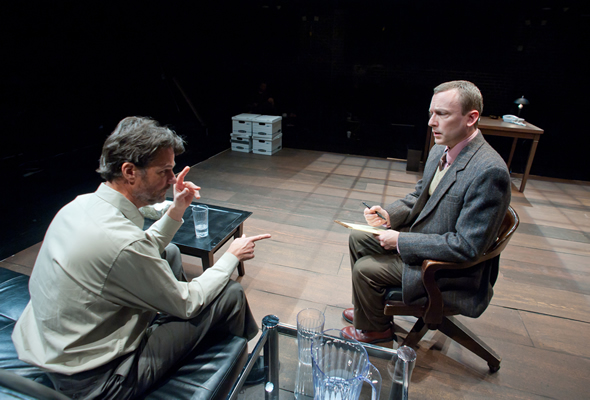A flowing white ribbon of carpet winds its way to a three-step platform where a woman, dressed all in white, sits motionless on a stool. She slowly awakens, makes some introverted movements, and sings in an unknown language/dialect to endlessly repeated triads on a pre-recorded god-awful, out-of-tune piano. This goes on for about forty minutes and then the first half is over. True, this sort of over-distillation, simplification can probably be applied to anything, but this description is an accurate reading of the opening act of the final event of Meredith Monk’s residency at Duke University.
One of the many benefits of being a critic is having the freedom and opportunity to experience artists and performances that I’d probably not attend as a “civilian.” Meredith Monk is one of those artists. While I have heard about her unique combination as composer, choreographer, singer, dancer, director of film and theater – just to name a few – I had not yet seen her in performance. This performance was a sort of “greatest hits” and microcosm of one of Monk’s most artistically fertile periods.
When the doors at Duke University’s Reynolds Theater finally opened at around 7:40 and we entered, the performance had actually already begun. Meredith Monk was the woman described above sitting absolutely fixed and inert. This was the start of the solo from Monk’s 1972 dance-opera Education of the Girlchild, a sort of examination of the human growth process in reverse. When Monk finally rose from her stool, she began a series of movements and vocalizations in her transmutation from old woman to child. This performance, and actually much of Monk’s works, invokes the philosophical question of the conflict of art as a transformative experience vs. entertainment. That will most certainly not be resolved here, but throughout much of the evening – as a virgin observer of Monk’s aesthetic – I felt that the remarkably positive and original aspects of her art were weighed down by a presentation that made many in the audience feel like shutout observers of an inside joke.
The second half brought out three of her dancer-singer associates: Ellen Fisher, Katie Geissinger and Allison Sniffin. It was another slow start to either build anticipation or annoyance from the audience. The stage was set up with three electronic organs and two of the singers came out with a lantern and sat on opposite ends of the stage. Then began Shards, a 2010 compendium of various works by Monk from the 1970s. Before this period in American music, not many people knew of or cared about the deliciously exotic and nearly bottomless expanse of unique vocal techniques from all over the world. While Monk’s vision of the enormous possibilities of the human voice were not necessarily derived from these cultures, her singular and exceptional development of these methods was, and still is, an enormous influence on composers and singers.
The second half was primarily a journey from the simpler one voice (usually Monk herself) to vocal trios that were quite exhilarating. The opening set was three pieces from Key: an album of invisible theatre. In one of those, Monk stood and played the organ and sang while an ominous figure approached her and alternated different sides of the keyboard in a sort of duo for piano and serial killer. Finally, in a quasi-burial rite, this first of three organs was covered and laid to rest: two to go.
Yes, this was the 1970s and Philip Glass and minimalism was all the rage, but did every piece need to be in that style. Well, apparently yes, if tonight’s music was the example. While each organ thankfully had some interesting settings, all of the music had endlessly pulsating repeated cells that grew tiresome very quickly. Eventually, this completely overpowered the best part of the concert: the brilliantly written and executed singing of all four of the participants. For the most part, the choreography was clunky and in some instances downright embarrassing. The theatrical and lighting aspects of the production, while not detracting from the experience, also did little to enhance the music.
At the age of 70, Meredith Monk is astoundingly youthful and obviously passionate about her art. While I was glad to finally experience her multi-faceted vision in the flesh, I am unable to say that this particular program prompts me to an encore. I will continue to explore her fascinating musical compositions through recordings.











